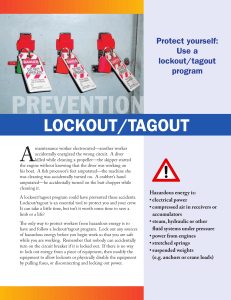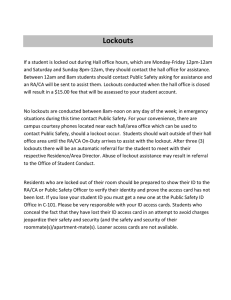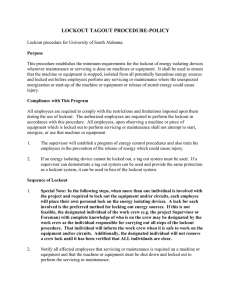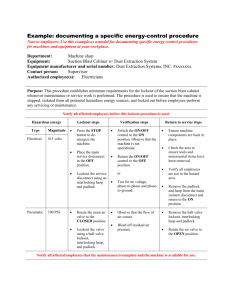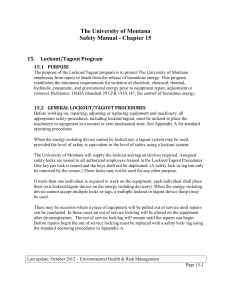LOCKOUT/TAGOUT Applicable Regulations and Programs Purpose
advertisement
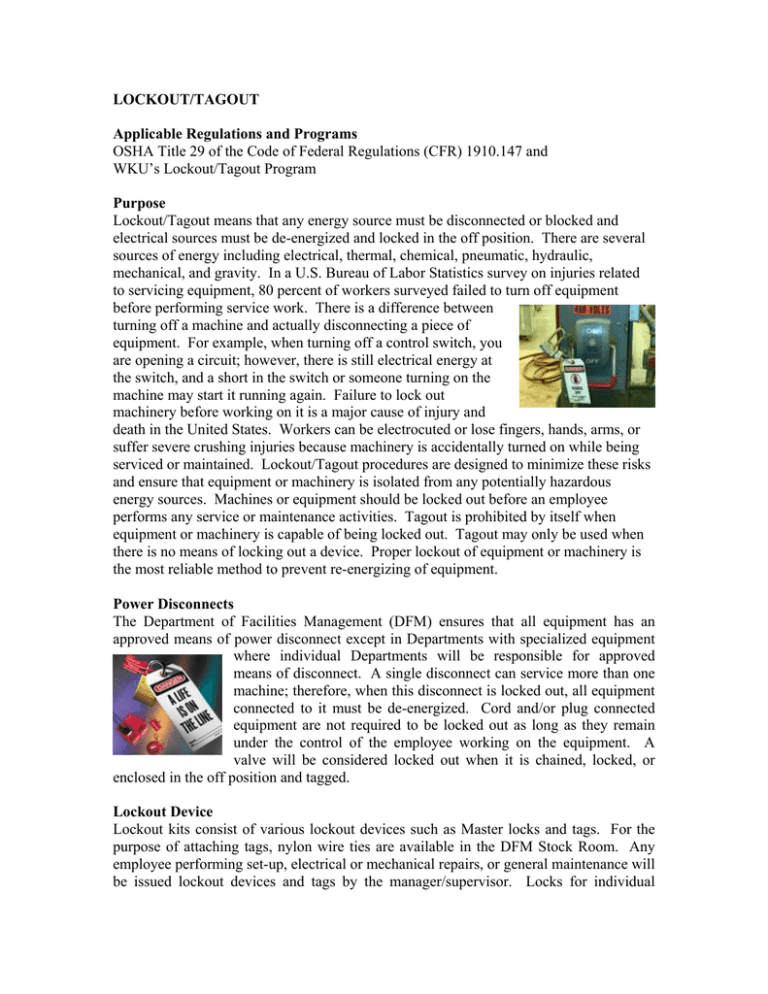
LOCKOUT/TAGOUT Applicable Regulations and Programs OSHA Title 29 of the Code of Federal Regulations (CFR) 1910.147 and WKU’s Lockout/Tagout Program Purpose Lockout/Tagout means that any energy source must be disconnected or blocked and electrical sources must be de-energized and locked in the off position. There are several sources of energy including electrical, thermal, chemical, pneumatic, hydraulic, mechanical, and gravity. In a U.S. Bureau of Labor Statistics survey on injuries related to servicing equipment, 80 percent of workers surveyed failed to turn off equipment before performing service work. There is a difference between turning off a machine and actually disconnecting a piece of equipment. For example, when turning off a control switch, you are opening a circuit; however, there is still electrical energy at the switch, and a short in the switch or someone turning on the machine may start it running again. Failure to lock out machinery before working on it is a major cause of injury and death in the United States. Workers can be electrocuted or lose fingers, hands, arms, or suffer severe crushing injuries because machinery is accidentally turned on while being serviced or maintained. Lockout/Tagout procedures are designed to minimize these risks and ensure that equipment or machinery is isolated from any potentially hazardous energy sources. Machines or equipment should be locked out before an employee performs any service or maintenance activities. Tagout is prohibited by itself when equipment or machinery is capable of being locked out. Tagout may only be used when there is no means of locking out a device. Proper lockout of equipment or machinery is the most reliable method to prevent re-energizing of equipment. Power Disconnects The Department of Facilities Management (DFM) ensures that all equipment has an approved means of power disconnect except in Departments with specialized equipment where individual Departments will be responsible for approved means of disconnect. A single disconnect can service more than one machine; therefore, when this disconnect is locked out, all equipment connected to it must be de-energized. Cord and/or plug connected equipment are not required to be locked out as long as they remain under the control of the employee working on the equipment. A valve will be considered locked out when it is chained, locked, or enclosed in the off position and tagged. Lockout Device Lockout kits consist of various lockout devices such as Master locks and tags. For the purpose of attaching tags, nylon wire ties are available in the DFM Stock Room. Any employee performing set-up, electrical or mechanical repairs, or general maintenance will be issued lockout devices and tags by the manager/supervisor. Locks for individual employees will be keyed separately and the employee will have possession and responsibility of the only key for their lock. General Procedure Each employee or crew performing work shall lock out the power source of any machinery or equipment to be repaired or serviced and safely release any residual energy prior to performing any tasks. A lockout device may only be removed by the employee who installed the device or by the employee’s manager. Specific Instructions Contact the supervisor of the department where the machinery or equipment is located. Review specific energy control procedures. Alert the machine operator or set-up person Disconnect equipment, before starting any work, by opening the disconnect switch or removing the plug. All valves must be placed in the closed position and any residual pressure relieved. Support or block any components that may fall. Attach the lockout device to the appropriate switch, valve or plug. After the equipment has been locked out, activate the operating controls to ensure the power source has been disconnected. If a crew is working on equipment or machinery, one of the following conditions must be met: each employee must place a lock on the lockout shackle, a designated crew leader will install and be responsible for one lock for his/her crew, or the supervisor of the department in which the equipment/machinery is located may place a lockout device on the disconnect. When work is completed, replace all guards and safety devices. Inspect the work area to ensure employees are safely positioned, nonessential items have been removed, and machinery components are intact before returning machinery to normal service. The appropriate employee, crew leader, or department supervisor should remove the lockout device and restore power. Each employee or crew leader must remove his/her lockout device upon assignment completion. If work is to be continued the next day by the same employee, the lock and tag may remain. If work is not complete and there is a shift change, the lockout device should be replaced by one from an employee or crew leader of the next shift. Only the employee who put the lock on shall remove it. When the employee is not available to remove the lockout device, it may be removed under the direction of the manager after the following procedures have been met: the manager verifies the employee who applied the lock is not at the facility, all reasonable efforts to contact the employee have been made, the manager has ensured the machine is safe to operate, and the authorized employee has knowledge of the actions before resuming work. Temporary Removal of Locks In situations where the lock must be temporarily removed to test or position the machinery or equipment, follow the sequence of actions below: 1. Clear the machinery or equipment of tools and materials 2. Remove employees from the machinery or equipment area 3. Remove the lock 4. Energize and proceed with testing or positioning 5. De-energize all systems and reapply energy control measures in the sequence set forth in Appendix A of the Lockout/Tagout Program Tags Lockout is the preferred method to guard against injury; therefore, the use of tags during de-energizing is limited to the following: machinery or equipment with energy isolating devices unable to be locked out or special situations where a tagout system will provide full employee protection. Each tag must indicate the identity of the employee who applies it. Reusable, non-locking tags such as string are not permitted. All tags must be non-reusable and self-locking with a minimum locking strength of no less than 50 pounds. Nylon cable ties are available in the DFM stockroom. Each tag contains a warning against hazardous conditions if the machine or equipment should be energized. Tagout Procedure In situations where tags are used, the lockout procedures listed above will be followed and the following additional requirements must be met: 1. Tagout will not be used unless it provides a level of safety equivalent to that obtained by lockout procedures. 2. Additional safety measures must be taken. 3. An authorized employee shall affix a tag to each energy-isolating device in a manner as to clearly indicate that the operation or movement of such devices is prohibited. 4. When a tag is used in addition to a lockout device, it shall be fastened at the same point as the lock. When a tag cannot be affixed directly to the energy-isolating device, it shall be located as close as safely possible to the device in a position that will be immediately obvious to anyone attempting to operate the device. 5. A tag may only be removed by the employee who placed it there. If the employee is unavailable, tag removal must have managerial approval. 6. No tag will be bypassed or ignored. The warning stated on the tag must be observed by all employees at all times. 7. Tags must be securely attached to each energy-isolating device so that the tag cannot be inadvertently or accidentally detached during use. 8. Tags are warning devices. They do not provide physical restraint like a lock. 9. Additional training is required when tagout programs are used. 10. Each supervisor is responsible for their area and the employees in that area. He/she shall take immediate action to protect employee safety and invoke disciplinary action if necessary.

